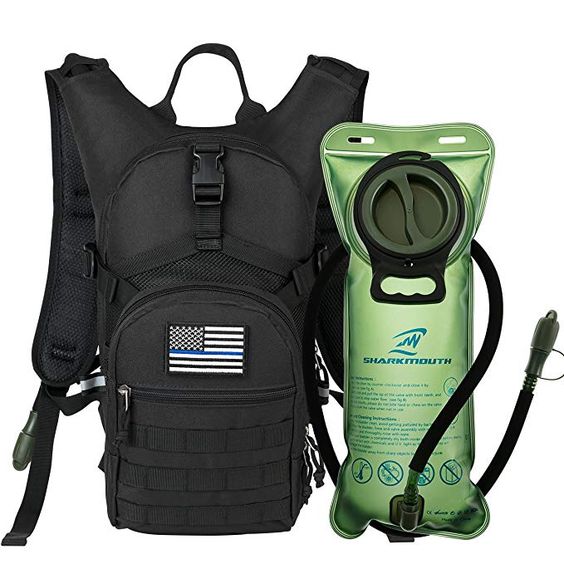There are a lot of trail running backpacks on the market today and many of them claim to be the best made at the best price. There’s a multitude of styles, sizes, uses, and materials and it can be slightly overwhelming to navigate through all the options.
Fortunately for you, we’ve come up with some of the features to look for when you’re looking to buy a new backpack for trail running.
Even if you’re an experienced trail runner and looking to upgrade your current pack, this list should help you find the right pack for you. We’ve also shared some tips when buying one in this post.
Contents show 1 Fit perfectly to your body 2 Material used 2.1 Backpacks made of Cordura 2.2 Backpacks made of Nylon 3 Weight of the backpack 4 Enough Pockets for your items 5 The Hydration Bladder 6 Survey your Environment 7 Last thoughts 7.1 Related posts:Fit perfectly to your body

Everyone has a different body type and so it’s important to look for a running backpack that fits your type the best and is the most important feature you should be looking for.
Imagine you’re Luke Skywalker and your backpack is Yoda from The Empire Strikes Back. You want your pack to feel like it’s clinging to your back and won’t jostle around and throw your balance off. In other words, you want a snug fit with your backpack and you want it to feel like it’s a part of you.
Getting the correct fit can make or break your trail running experience so make sure you try on a lot of different backpacks and research what running backpack is best for your particular body type. Not all backpacks are made for every type of body.
Material used
There’s a lot of different materials but the most commonly used for trail running backpacks are Cordura and nylon. Both have their advantages and both have disadvantages that, while mostly insignificant, should be considered before you choose that particular pack material.
Backpacks made of Cordura
Cordura is one of the most durable and water-resistant materials outdoor companies use to make a fair amount of their equipment. As compared to many of the other materials on the market, Cordura is advertised as the modern Mithril and comes close to measuring up.
Water and pierce-resistant, Cordura is a great material for most trail runners. There are a few drawbacks, however.
One of the biggest issues with Cordura is its cost, typically 10-20% more expensive than non-Cordura packs. The sturdier composition creates more production costs in terms of the material itself and the backpacks made of Cordura.
Another issue Cordura users might face is its overall weight. Due to its sturdy construction, it uses quite a lot of production material which makes it heavier than its nylon counterparts.
Backpacks made of Nylon
Nylon and nylon mixes, usually cheaper and lighter, are a great option for a lot of trail runners and day hikers. It’s water-resistant and generally cheaper than most Cordura products. Its liability comes in its lack of durability and tendency to break down a little quicker in rough terrain.
Aside from Cordura and nylon, there are a lot of other materials that provide lightweight, high durability, and high water resistance. The problem with a lot of these materials is their extreme cost.
Cuben fiber, one of the lightest waterproof materials, costs upwards of $30 per cubic yard making it very expensive to make backpacks.
Though extremely light and highly waterproof, for most these options won’t be worth the cost.
Weight of the backpack

Though most wouldn’t think weight is a huge feature to consider before buying a backpack for trail running, it is something most should consider.
Not only should they consider the weight of the backpack itself, but also the weight capacity and how much weight it can carry without degrading the structural integrity of the backpack.
For most, this will be one of the last features to consider however it can make a huge difference if you plan to participate in races or other trail running competitions.
Typically, a good running backpack will weigh just under or right around a pound depending on the material and size of the pack.
Though marginally important, don’t overlook how much a backpack weighs. It could save you large amounts of energy when running.
Enough Pockets for your items
Pockets are a feature that really comes down to personal preference and most likely use of the backpack.
For longer, more grueling runs you may want a pack with a few more pockets to store snacks and essentials. Typically you’ll want something that can hold just the right amount without becoming overloaded or bulky.
Many backpack makers have begun incorporating pockets on the hip belts of their backpacks to ease access to energy gels and trail snacks. These pockets are great for allowing you to access your snacks without having to take the backpack off or without slowing down too much.
The Hydration Bladder

Most running backpacks today either come with a hydration bladder or come with a pocket for a hydration bladder. Similar to pockets, the hydration bladder really comes down to personal preference and the individual user.
Some runners prefer to use a water bottle and therefore need a backpack with the ability to hold one or two water bottles while they’re running. The disadvantage to these types of backpacks and using water bottles instead of a bladder can result in the pack feeling lopsided while you’re running.
Others prefer the hydration bladder and drinking straw so they can sip water while maintaining their speed. The hydration bladder also prevents you from losing your water source as the bladder is usually inside the backpack itself. Those who don’t like the drinking straw complain that they feel short of breath after having to suck water from the tube.
Again, this feature may seem marginal, but it is important not to overlook and may affect the cost of the pack you decide to get. For more information about the importance f hydration bladder, check out my earlier post on hydration bladder.
Survey your Environment
This is the only feature that isn’t about the pack itself but the environment in which you plan to use the pack. For example, the backpack you want for trails in Utah may be different than the backpack you use in Washington State.
The environment can dictate many of the decisions you need to make about the different features you have to consider. For Utah, you may want a Cordura pack because of the rocky and arid terrain while in Washington State you may only need a nylon mix due to the high levels of rain.
Last thoughts
This is by no means an all-inclusive list of features to consider before buying a trail running backpack. It is, however the basic features you’ll want to look at before spending upwards of $100 on a pack.
Have more features you think trail runners should look for before buying a backpack for trail running? Let us know in the comments section.
Related posts:
Best Sling Backpack For Hiking in 2022Best Hunting Backpack in 2022How do I Secure My Motorcycle Backpack<!– –> Junyuan BagsTen articles before and after
Topologie Haul Backpack Review – A Modern Backpack Tote | JUNYUAN
4 Best Backpacks For Running To Work [January 2022]
Top 10 Best Bushcraft Backpacks [January 2022]
Finding the Best CrossFit Backpack – Top Picks | JUNYUAN
Best Business Casual Backpacks – When Smart Style Meets Urban Carry | JUNYUAN
4 Best Commuter Backpacks For Cyclists [January 2022]
Topologie Satchel Backpack Dry Review – Minimalist Backpack for Work and Play | JUNYUAN
Waterproof Laptop Backpack craftsman tool bags




 Mobile/What's App/Wechat
Mobile/What's App/Wechat E-Mail
E-Mail ADD
ADD




